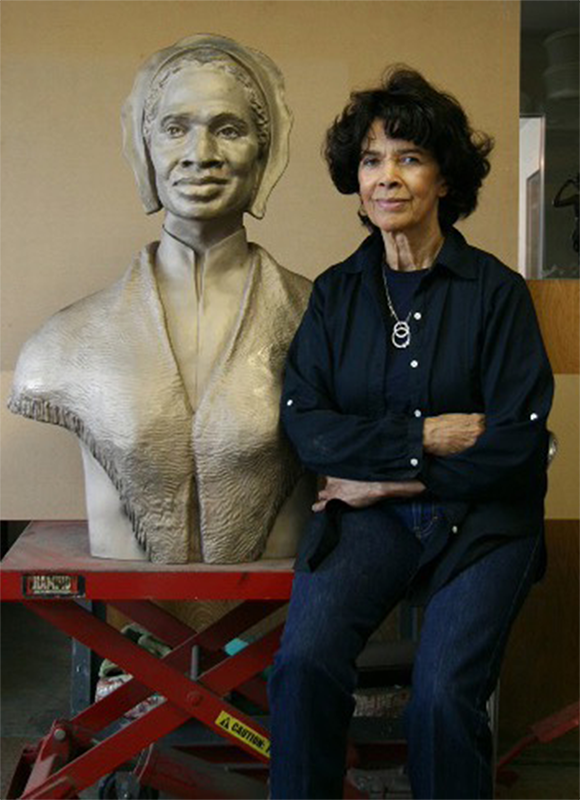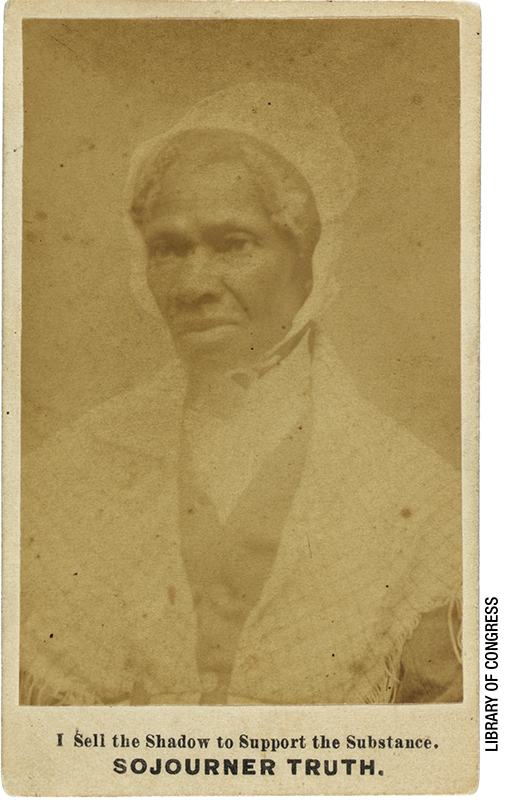Sojourner Truth

Unveiled in Emancipation Hall on April 28, 2009, the bronze bust of Sojourner Truth is the first sculpture honoring an African American woman in the U.S. Capitol. Donated by the National Congress of Black Women, Congress authorized its placement in the Capitol (Public Law 109-427), and President George W. Bush signed the bill into law December 6, 2006. California-based sculptor Artis Lane, who designed the Rosa Parks Congressional Medal of Honor, was commissioned to create the bust. Lane depicted Truth with a smile to show Truth's confidence and determination for equal rights for women and African Americans.
Born to enslaved parents in Dutch-speaking Ulster County, New York, in 1797, Truth was originally named Isabella Baumfree. Tragically, she was sold from her parents as a small child to John Neely for $100 and a few sheep. By the age of 13, she had been sold two more times, ending up in West Park, New York, and enslaved by John Dumont.

As a young woman and mother, she ran away with her baby Sophia in search of freedom, finding shelter with an abolitionist family, the Van Wagenens. She recalled, "I did not run away; I walked away by daylight." The Van Wagenens bought her freedom for $25 and helped her successfully sue for the return of her five-year-old son Peter. Peter lived in New York and was illegally sold by John Dumont to a plantation in Alabama after the New York Anti-Slavery law was passed in 1827. The judge of the Ulster County Court House in Kingston, New York, ruled in her favor in 1828, making Truth the first Black person to win a court case against a white man.
 After winning freedom for Peter, Truth moved to New England, where she preached and became a freedom fighter for enslaved African Americans and women's rights. In 1843, she felt compelled to change her name to Sojourner Truth . As she advocated for equality, Truth met with many leaders, including Frederick Douglass, Susan B. Anthony and Abraham Lincoln. Truth never learned to read or write, but that did not stop her from speaking out against injustice. What we know of her speeches is, therefore, based on other people’s accounts of her words.
After winning freedom for Peter, Truth moved to New England, where she preached and became a freedom fighter for enslaved African Americans and women's rights. In 1843, she felt compelled to change her name to Sojourner Truth . As she advocated for equality, Truth met with many leaders, including Frederick Douglass, Susan B. Anthony and Abraham Lincoln. Truth never learned to read or write, but that did not stop her from speaking out against injustice. What we know of her speeches is, therefore, based on other people’s accounts of her words.
In 1851, Truth attended the Women's Rights Convention in Akron, Ohio, where she delivered her most famous speech, known today as "Ain’t I a Woman." This speech is recognized as one of the most abolitionist and pro-women's rights speeches in American history. She suggested that the women's rights movement had marginalized African American women and stated, "You need not be afraid to give us our rights for fear we will take too much, for we can't take more than our pint'll hold."
 Truth’s many speeches and autobiography, “ The Narrative of Sojourner Truth ,” won over audiences with her artful persuasion.
Truth’s many speeches and autobiography, “ The Narrative of Sojourner Truth ,” won over audiences with her artful persuasion.
When the Civil War started, Truth organized supplies for the troops and recruited young Black men to join Union forces. During the war, she visited campgrounds to nurse and counsel freed slaves.
After the war and emancipation, Truth's work was still not finished; she began advocating against segregation. One day in the mid-1860s, when a conductor operating a streetcar tried to violently block her from riding, she pressed charges against him and won her case.
Sojourner Truth’s fervent activism for the rights of African-Americans and women continued until her death in 1883. She will always be remembered for her confidence, determination and fight for freedom.
Sojourner Truth Image Source
For more information on the Statue of Freedom download our augmented reality app, Who Are the People?, for an interactive experience.